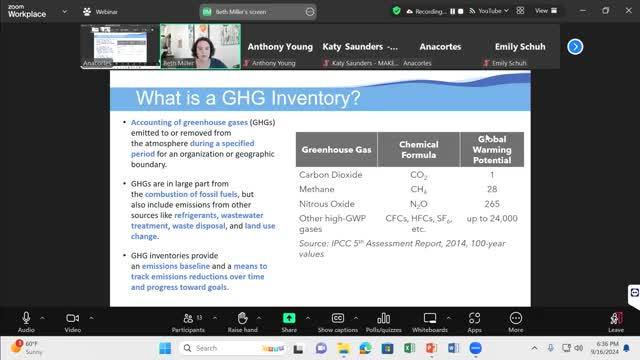City of Anacortes reveals alarming greenhouse gas emissions data
September 16, 2024 | Anacortes, Skagit County, Washington
This article was created by AI summarizing key points discussed. AI makes mistakes, so for full details and context, please refer to the video of the full meeting. Please report any errors so we can fix them. Report an error »

In a recent government meeting, officials presented a comprehensive greenhouse gas emissions inventory for the City of Anacortes, revealing significant insights into local emissions sources and trends. The inventory, which covers activities from the calendar year 2022, aims to establish a baseline for tracking progress in reducing greenhouse gases, primarily focusing on carbon dioxide, methane, and nitrous oxide.
The total emissions for Anacortes were reported at nearly 500,000 metric tons of CO2 equivalent (CO2e), with local emissions accounting for about half of this total. The breakdown of emissions sources indicated that 61% stemmed from building energy use, primarily heating and electricity, while transportation contributed 36%. The remaining 3% was attributed to waste and refrigerant usage.
Per capita emissions in Anacortes were slightly higher than the state average, with residents emitting approximately 13.7 metric tons per person compared to Washington's average of 13.5 metric tons. Notably, emissions from residential buildings were significantly higher than the state average, while transportation emissions were somewhat lower.
The meeting highlighted the importance of understanding the various components of emissions. For instance, the data revealed that passenger vehicles accounted for 32% of transportation emissions, with waterborne navigation also playing a substantial role due to the city's maritime activities. The inventory also noted that Anacortes' urban forest sequesters nearly 5% of the city's carbon emissions, showcasing the environmental benefits of maintaining green spaces.
Looking ahead, officials discussed the potential impact of state and national legislation on future emissions, projecting significant reductions in various sectors, particularly in transportation. The meeting underscored the city's commitment to tracking and reducing greenhouse gas emissions as part of broader environmental goals.
The total emissions for Anacortes were reported at nearly 500,000 metric tons of CO2 equivalent (CO2e), with local emissions accounting for about half of this total. The breakdown of emissions sources indicated that 61% stemmed from building energy use, primarily heating and electricity, while transportation contributed 36%. The remaining 3% was attributed to waste and refrigerant usage.
Per capita emissions in Anacortes were slightly higher than the state average, with residents emitting approximately 13.7 metric tons per person compared to Washington's average of 13.5 metric tons. Notably, emissions from residential buildings were significantly higher than the state average, while transportation emissions were somewhat lower.
The meeting highlighted the importance of understanding the various components of emissions. For instance, the data revealed that passenger vehicles accounted for 32% of transportation emissions, with waterborne navigation also playing a substantial role due to the city's maritime activities. The inventory also noted that Anacortes' urban forest sequesters nearly 5% of the city's carbon emissions, showcasing the environmental benefits of maintaining green spaces.
Looking ahead, officials discussed the potential impact of state and national legislation on future emissions, projecting significant reductions in various sectors, particularly in transportation. The meeting underscored the city's commitment to tracking and reducing greenhouse gas emissions as part of broader environmental goals.
View full meeting
This article is based on a recent meeting—watch the full video and explore the complete transcript for deeper insights into the discussion.
View full meeting
